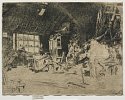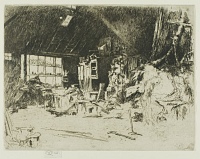Etchings Institutions search term: wunderlich
The Smithy | ||
| Number: | 239 | |
| Date: | 1880 | |
| Medium: | etching and drypoint | |
| Size: | 177 x 229 mm | |
| Signed: | butterfly at lower right | |
| Inscribed: | no | |
| Set/Publication: | no | |
| No. of States: | 6 | |
| Known impressions: | 20 | |
| Catalogues: | K.240; M.237; W.197 | |
| Impressions taken from this plate (20) | ||
STATE
Six states are known before cancellation.
State 1

Signed with a butterfly at lower right, at the foot of the anvil.
The basic composition is complete, apart from the sketchy figure to the left of the large anvil and the area around him.
State 2

Left to right diagonal lines (\\\) are added along the top edge of the image, from the beam of light at centre to the upright timbers above the forge.
State 3

Several short right to left diagonals (///) are added on the hip of the figure working at the anvil at right; many fine lines darken the ceiling and background, most notably left to right diagonals over the rafters above the large window, fine long left to right diagonal and almost horizontal lines on the beam of light at centre, curving diagonals on the area to right of the beam of light and lines in all directions to right of the cupboard at centre; the lower skylight has a more rectangular shape, and its panes are more clearly indicated; short slightly diagonal lines on the upper left of the chimney-like shape below the cupboard are worn or reduced in strength.
Kennedy thought that part of the sketchy figure to left of the butterfly and anvil at right had been removed in this state, but that does not appear to be the case. 6 His collotype illustration is blurred in that area, which may have led him to believe that lines had been changed. In addition, impressions of the first three states of The Smithy tend to be printed with retroussage or a great deal of ink in the areas of darkest shading, making differences in line work difficult to distinguish.
6: Kennedy 1910 , cat. no. 240 state 3.
State 4

The torso and head of the figure to the left of the large anvil are removed except for a few outlines; fine drypoint shading is added to and in front of the legs of that figure; more shading is added to the ceiling and background, including short right to left diagonals (///) on the beam of light at centre and closer work above and below it.
The impression illustrated is printed with plate tone across the top of the plate, somewhat obscuring the lines in the centre.
State 5

The torso and head of the figure to left of the large anvil are almost completely removed, as is the drypoint shading on and in front of his legs; diagonal shading is added to the objects on top of the cupboard, and the largest ones are almost totally shaded; fine diagonal shading is added across the entire ceiling, including the rafters and the beam of light that runs across it; fine diagonal and horizontal shading is added to the upright timbers above the forge, to the flue and to the lower part of the wall between them.
State 6

Patches of dark shading are added among the rafters at left, to the left of and above the cupboard and on its right side, and above and below the beam of light; very short lines are added to the lower skylight, redefining the panes; some shading on the objects on the cupboard, the upright timbers above the forge and the flue has worn away.
Impressions of the final state vary considerably. The earliest, as illustrated above, have clear new work on the lower skylight and stray marks on the lower back of the rightmost figure. Later impressions show wear to the fine shading on the ceiling background and were printed with varying amounts of plate tone across the top of the plate to partially compensate for the wear (see example below).
One almost clean-wiped impression of the final state, reproduced below, shows the extent of wear at or near the end of the plate's printing life.



